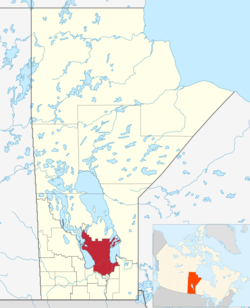Top Qs
Timeline
Chat
Perspective
Interlake Region
Region of Manitoba in Canada From Wikipedia, the free encyclopedia
Remove ads
The Interlake Region is an informal geographic region of the Canadian province of Manitoba that lies roughly between Lake Winnipeg and Lake Manitoba in the Canadian province of Manitoba.
The region comprises 14 rural municipalities, one city (Selkirk), six towns (Arborg, Riverton, Stonewall, Gimli, Teulon and Winnipeg Beach), and one village (Dunnottar). The largest population centre in the region is Selkirk, and the second largest is the town of Stonewall.
Argyle is a small hamlet that is located on the Principal Meridian of Canada, near the middle of the Interlake Region. Sandy Hook is located between Winnipeg Beach and Gimli, a popular summer vacation spot.
Remove ads
Geography
Summarize
Perspective
The Interlake Region geographically is a low lying glacial lake basin that is poorly drained.[2] The area is clearly defined on the west by the shores of Lake Manitoba and on the eastern edge by Lake Winnipeg. The northern and southern boundaries are less clearly defined geographically. The geography of the region is mostly composed of sandy beaches, wetlands, lakes, bogs, marshlands, agricultural fields, glacial till, rocky shorelines, and oak, aspen, and eastern cedar forests.[2] The topography is mostly level and poorly drained, swamps exist in all portions of the region.[3] The soils are mostly shallow and mixed with lime and thus mostly infertile.[3] Agricultural areas do thrive in the regions surrounding the Icelandic River basin in the north around Arborg and Riverton, as well as in the area east of Teulon and close to Gimli.
Climate
The climate of the area is moderated by the lakes and overall is slightly cooler than the weather found in Winnipeg and southern Manitoba.
Remove ads
Demographics
Major communities
Census subdivisions
The Interlake Economic Region is made of three subdivisions according to Statistics Canada which includes Divisions No. 13, No. 14, and No. 18.
Remove ads
See also
- Interlake-Gimli — provincial electoral district
- Interlake — former provincial electoral district
- Selkirk-Interlake — federal electoral district
References
- Community Profile: Census Division No. 13, Manitoba; Statistics Canada Archived 2007-03-10 at the Wayback Machine
- Community Profile: Census Division No. 14, Manitoba; Statistics Canada Archived 2007-03-10 at the Wayback Machine
- Community Profile: Census Division No. 18, Manitoba; Statistics Canada Archived 2007-03-10 at the Wayback Machine
References
External links
Wikiwand - on
Seamless Wikipedia browsing. On steroids.
Remove ads

